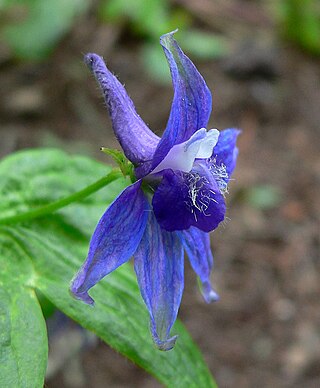
Delphinium bakeri, or Baker's larkspur, is a species of perennial herb in the buttercup family, Ranunculaceae. It is endemic to California in the United States, where it is a federally listed endangered species. It is known in the wild from one remaining occurrence near Salmon Creek in Sonoma County, where only seven plants remained as of March 2006.
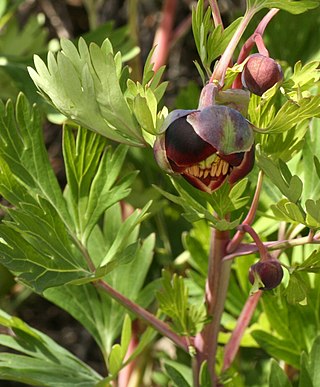
Paeonia californica is a perennial herbaceous plant of 35–70 cm high, that retreats underground in summer, and reoccurs with the arrival of the winter rains. It has lobed leaves, elliptic (cup-shaped) drooping flowers with dark maroon-colored petals, and many yellow anthers. It flowers mostly from January to March, and later develops two to five fruits per flower. Its common name is California peony and it is sometimes also referred to as wild peony. This peony is an endemic of southwestern California (USA), where it is not rare, and northernmost Baja California (Mexico). It grows on dry hillsides in the coastal sage scrub and chaparral communities of the coastal mountains of Southern and Central California, often as an understory plant.

Papaver californicum is a species of poppy known by the common names fire poppy and western poppy.

Delphinium andersonii is a species of perennial larkspur known as Anderson's larkspur. This wildflower is native to western North America, where it can be found in the Great Basin and the Sierra Nevada.
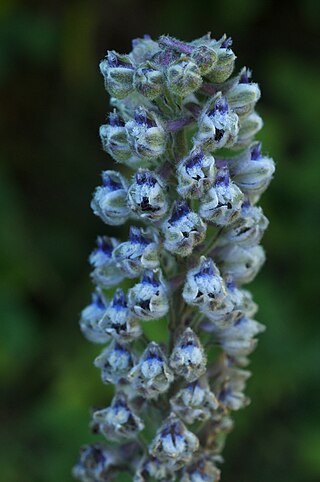
Delphinium californicum is a species of larkspur known as California larkspur. This wildflower is endemic to California, where it is a resident of the chaparral slopes of the San Francisco Bay Area and Central Coast.

Delphinium cardinale is a species of larkspur known by the common names scarlet larkspur and cardinal larkspur. This wildflower is native to California and Baja California, where it grows on coastal, inland, and desert chaparral slopes, such as the Colorado Desert, and the Peninsular and Transverse Ranges. The presence of diterpenoid alkaloids, probably including the highly toxic methyllycaconitine, in above-ground parts of D. cardinale means that they are likely to be toxic if ingested.
Delphinium decorum is a species of larkspur known by the common names coastal larkspur and yellow-tinge larkspur. This wildflower is native to California and Oregon, where it grows on the slopes of the coastal ranges from the San Francisco Bay Area north to the southern Oregon coast. It has an erect stem which approaches half a meter in height at maximum. The leaves, which are divided into a number of narrow lobes, are mostly located about the base of the plant. The spindly stem above bears two to twenty widely spaced flowers. Each flower is carried on a pedicel several centimeters long. The five long, flat sepals are extended to give the face of the flower a star shape, and they are usually deep blue to purple. The petals are similar in color, except the top two may be lighter to almost white. The spur is very thin and may be nearly two centimeters long.

Delphinium depauperatum is a species of larkspur known by the common names slim larkspur and dwarf larkspur. This wildflower is native to western North America where it is found in mountain meadows. It grows from a short root and erects a stem usually under 40 centimeters in maximum height. The small leaves are divided into lobes and are usually located about the base of the plant. Toward the top of the stem are flowers on long pedicels, with usually not more than 20 flowers per plant. The flowers generally have deep dark blue sepals which are flat and extended to the sides, and petals which are mainly the same color except for the top two, which may be lighter blue to white. The spur is between one and two centimeters long.

Delphinium hesperium is a species of larkspur known by the common name foothill larkspur. It is also sometimes called western larkspur and coastal larkspur, but these names are less specific since other species share them. It is endemic to California, where it grows in woodland and grassland in the northern half of the state. This wildflower generally reaches one half to one meter in height. It has deeply lobed, prominently veined leaves, mostly located near the base of the plant. The inflorescence may hold very few to over 100 flowers, each on a long, thick pedicel. The flowers are usually a brilliant blue or purple, and sometimes lighter pinkish to white. Often the sepals are dark in color and the petals lighter. The spur is about one to two centimeters long.

Delphinium nuttallianum is a species of larkspur known by the common names two-lobe larkspur, upland larkspur, common larkspur, and Nuttall's larkspur. It is widely distributed across western North America from California to Alberta, including mountain meadows and the majority of the sagebrush steppe, except very dry areas.

Delphinium recurvatum is a species of larkspur known by the common names Byron larkspur, recurved larkspur, and valley larkspur. It is endemic to California, where most of its historical range is in the Central Valley. The grasslands of the valley have been mostly claimed for development and agriculture, so this species is now uncommon. This wildflower reaches a maximum height of about half a meter. Its deeply lobed leaves are mainly basal, with those located further up the dark purple stem being much smaller. The flowers are generally blue, with the sepals and lower petals darker than the upper petals. The sepals are usually curved back, the trait which gives the plant its name.
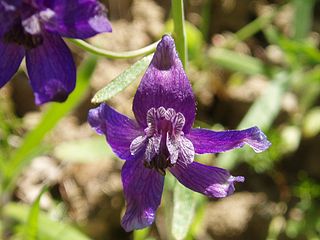
Delphinium variegatum is a species of larkspur known by the common name royal larkspur. It is endemic to California, where it grows in mountains, valley and coast in woodlands and grasslands. On the forest floor of California oak woodlands typical plant associates are Calochortus luteus, Cynoglossum grande and Calochortus amabilis.

Clematis occidentalis is a species of flowering plant in the buttercup family known by the common name western blue virginsbower. It is native to much of southern Canada and the northern United States. There are three varieties: var. occidentalis is limited to the eastern half of the species' range, var. grosseserrata to the western half, and var. dissecta is endemic to Washington. The plant varies somewhat in appearance. Generally they produce vines and climb on surfaces. The leaves are divided into three thick, green leaflets, which may have lobes or teeth. The flower has no petals, but petallike sepals which are usually either deep purple-blue in western populations or reddish purple in eastern plants. White flowers are rare.
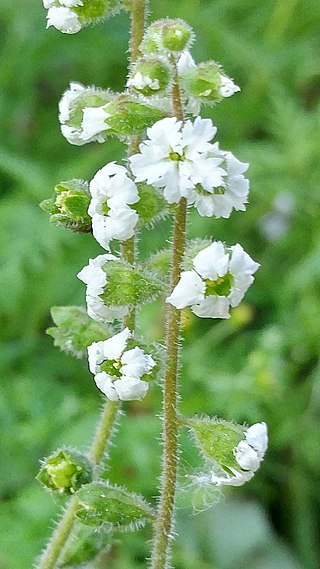
Lithophragma maximum, known by the common name San Clemente Island woodland star, is a rare species of flowering plant in the saxifrage family. It is endemic to San Clemente Island, one of the eight Channel Islands of California. It is known from only about four kilometers of rocky coastal cliffs on the edge of the island. The plant was thought to be extinct until a few specimens were rediscovered in 1979. Only 200 individuals were tallied in a 1996 survey. In 1997 the plant was listed as an endangered species on the federal level.
Malacothamnus abbottii is a rare species of flowering plant in the mallow family known by the common name Abbott's bushmallow. It is endemic to Monterey County, California, where it has recently been observed at only a few locations. It was historically known from a single specimen collection and the plant was presumed extinct until it was rediscovered in 1990 near San Ardo in the Salinas River drainage. It is now known from eleven occurrences, many of which are actually part of a single population, growing in vulnerable riverbeds near oil fields. Its habitat is periodically flooding riparian scrub among sandbar willows. This is a shrub with a slender, branching stem growing erect to a maximum height over one meter. It is coated in thin white hairs and bears toothed oval leaves a few centimeters long, sometimes divided into lobes. The inflorescence is a cluster of a few pale pink flowers with pointed oval petals 6 or 7 millimeters long.

Malacothamnus davidsonii, also known by the common names Davidson's bushmallow and Davidson's bush mallow, is a species of flowering plant in the mallow family.
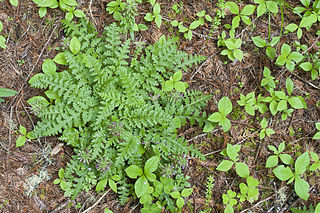
Pedicularis dudleyi is a rare species of flowering plant in the family Orobanchaceae known by the common name Dudley's lousewort. It is endemic to central California, where it is known from about ten scattered occurrences along the coast and in the coastal mountain ranges. It has been found in three locations along the Central California coast. The species was named for 19th-century Stanford University botanist William Dudley.

Sidalcea oregana is a species of flowering plant in the mallow family known by the common name Oregon checkerbloom.
Silene serpentinicola is a rare species of flowering plant in the family Caryophyllaceae known by the common name serpentine Indian pink and serpentine catchfly.
Delphinium viridescens is a species of flowering plant in the buttercup family known by the common name Wenatchee larkspur. It is endemic to central Washington state in the United States, where it occurs in the Wenatchee Mountains in Chelan and Kittitas Counties.
















